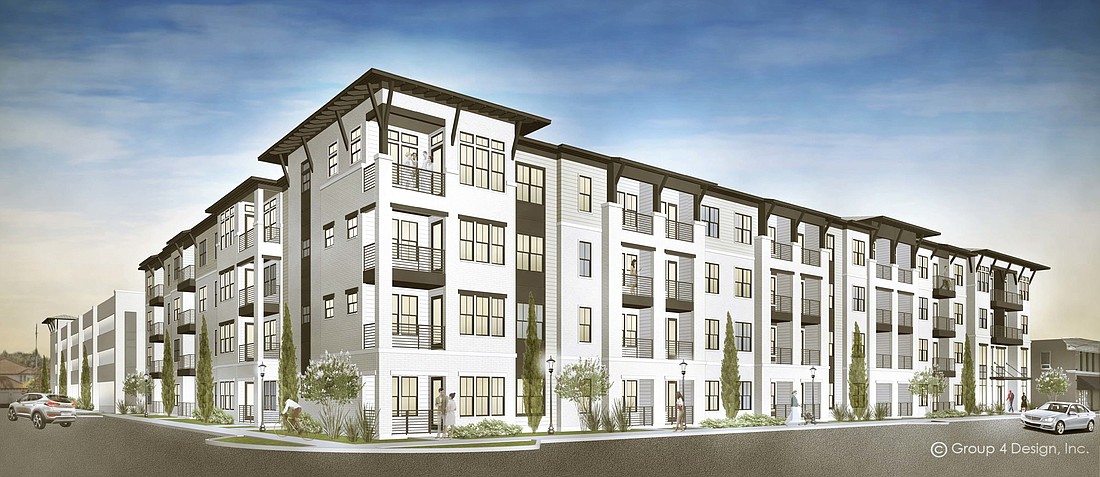
More than 200 people gathered Tuesday at South Jacksonville Presbyterian Church to hear details and voice their concerns about the Park Place at San Marco apartment project, which would be built on part of the church’s property.
Concerns included traffic and the number of apartments under development, while some neighbors supported the additional parking it will provide.
The San Marco Preservation Society hosted the meeting. President Linzee Ott said the group’s board has not decided whether to support or oppose the project.
Corner Lot Development Group CEO Andy Allen, Harbert Realty Vice President of Development Bill Ware, Group 4 Design Principal Karie Kovacocy and EnVision Design + Engineering civil engineer Doug Skiles presented the project.
Park Place at San Marco will sit on 2.09 acres bounded by Hendricks Avenue, Alford Place, Mango Place and Mitchell Avenue. It’s across from San Marco Square.
The project will have 141 units, most of which will be on the northern end of the property, with several on the southern side of the parking garage.
The southern units were added to block the view of the parking garage for the homes along Mitchell Avenue.
The community will have 82% one-bedroom apartments and 18% two-bedroom apartments. Ware said ideally, its residents would be young professionals and empty nesters. Average rent would be $1,700 per month.
A 302-space, three-floor parking garage will sit at the corner of Mitchell Avenue and Mango Place, with resident entrance and exit on Mango Place. Residents will have 198 spaces, the church will have 104. Of the 104 for the church, 74 will be on the ground floor of the garage, and open to the public when not used by the church.
Construction would begin in June or July and take about 16 months to complete, Ware said.
South Jacksonville Presbyterian Church announced in July it would evaluate the highest and best use of its 2.4-acre property in San Marco. It selected the Park Place at San Marco project.
In July, the church’s chair of trustees, Jeff King, said the church was built for a membership of around 2,000. It’s congregation is less than 250 today.
The church will retain the sanctuary space for worship, as well as the administration building and community hall. That leaves the church with less than an acre of property.
To reduce traffic impact, Ware said the property would be pedestrian friendly so that residents could walk or bike to nearby restaurants, entertainment or offices. It also would include lighting that doesn’t produce light pollution.
Skiles, the civil engineer on the project, said multifamily projects are some of the lowest traffic generators in terms of property zoning. The development group also would be open to mitigating traffic on Hendricks and Mitchell avenues.
In front lawns of nearby houses there are signs that read “Let’s Get It Right.” The signs were distributed by a group called Right Size San Marco, a coalition of residents, families and local business owners “desiring responsible, smart, growth in San Marco.”
The group expressed concern on its website about the San Marco Crossing, San Marco Promenade, East San Marco and Park Place at San Marco developments that are happening around the same time. Construction has begun on the San Marco Crossing and San Marco Promenade apartment communities.
Increased traffic from the developments was one of the concerns from residents who spoke at the meeting. Some said they didn’t think all the residents would be working from home as the developers envision they will, creating more traffic. Some said the complex has too many units.
“I feel like this is too many apartment complexes that do not mesh with the vibe of San Marco,” one speaker said. “This is how a lot of us are feeling right now.”
Some were optimistic about the project, saying that adding a parking garage with public access would benefit the neighborhood. Another said an increase in apartments in the neighborhood would be good and help it to further develop.
City Council member Matt Carlucci spoke during the public comment segment of the meeting, saying he “can’t not speak for my neighborhood,” and urged the developers to listen to the community’s requests.
“We’ll be left with the project,” he said. “They have not had a chance to speak with the development team.”
Carlucci said that was the missing link.
“If you do that – and there will be some give and takes and some change – this probably will work. If you don’t do that, I think you’re missing a chance to build goodwill. And I know that’s how so many of my neighbors feel.”